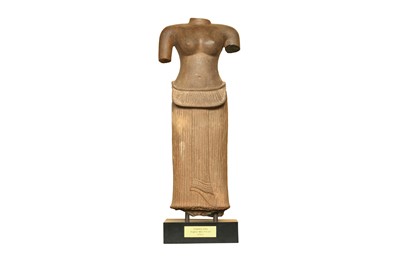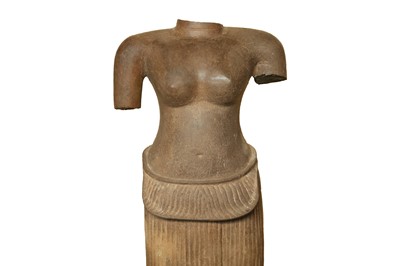29th Apr, 2022 13:00
Islamic & Indian Art
A KHMER CARVED SANDSTONE STANDING STATUE OF A FEMALE GODDESS (UMA)
Cambodia, South East Asia, Angkor Wat style, circa 1100 - 1175
A KHMER CARVED SANDSTONE STANDING STATUE OF A FEMALE GODDESS (UMA)
PROPERTY FROM THE LATE JEAN-PIERRE YONAN COLLECTION
Cambodia, South East Asia, Angkor Wat style, circa 1100 - 1175
Carved in the round on four sides as a free-standing statue, the naked torso highlighting the goddess's gently sloping shoulders, her full and rounded breasts, her slender waist, and wide, curvy hips, the typical sarong skirt showcasing multiple narrow pleats, a long vertical hem forming a triangular ruffle (also called fish-tail pleat) near the left ankle, and a double-folded drape around the waistline, both head and arms now missing, mounted on a black stand with a copper plaque reading Goddess Uma, Angkor Wat Period, 12th century, 56.3cm including the stand.
Provenance: In the private collection of Jean-Pierre Yonan in his London flat since the 1980s.
In terms of style and content, this sculpture can be easily attributed to the artistic production dating to the Khmer Angkor Wat period, often considered by art historians an extension of the Baphuon style and the true apogee of Cambodian art. Harmonious symmetry; perfected balance; thorough understanding of the employed media; and enhanced decorative quality and compositional genius all mingle into the creation of an immortal aesthetic unaffected by the passing of time.
Our naked torso shows a clear understanding of the human body presented with youthful breasts, a slim waist, and most importantly, a refined and sensitive rendition of curves both in silhouette and profile. The proportions are rather realistic and accurate, pre-dating the increased volumes and almost caricatural quality of sculptural creations in the Bayon style. The emphasis is still on stasis rather than movement like in the Baphuon period, but here, an element of elegance is blended into the apparent stiffness of the body. The absence of limbs and head of this statue forces the viewer to concentrate on the remaining details, which are by no means scarce. Indeed, the pleated sarong terminating in the flaring 'fishtail' motif showcases fine carving skills and it also helps us with the attribution of this lot to the Angkor Wat period thanks to comparable visual references to the fashion of the time and the contemporary trends of how sarongs were worn, as evident in the case of the rare free-standing sculptural survival of Female Divinity in the National Museum of Cambodia in Phnom Penh (acc. no. Ka 1867). For further examples of sarong patterns, please refer to this website http://www.tevoda.com/khmerart.html, last accessed: 03/03/2022.
For further comparison with similar 12th-century naked torsos of Khmer Goddesses, please see W. Felten and M. Lerner, Thai and Cambodian Sculpture from the 6th to the 14th centuries, 1988, pl. 28, p. 215; H. Ibbitson Jessup and T. Zephir, Sculpture of Angkor and Ancient Cambodia: Millennium of Glory, 1997, cat. 71, p. 264; the Walters Art Museum Female Deity, possibly presenting Vishnu's consort, the Goddess Lakshmi (acc. no. 25.212 - https://art.thewalters.org/detail/32938/female-deity/, last accessed: 03/03/2022); and the torso offered last year at auction in Germany at the auction house Hermann Historica, 26 May 2021, lot 476.
Sold for £4,750
Includes Buyer's Premium
Do you have an item similar to the item above? If so please click the link below to submit a free online valuation request through our website.






